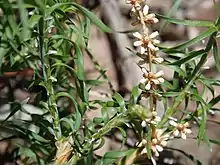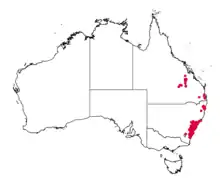Lomandra obliqua
Lomandra obliqua, known as fish bones and twisted mat-rush,[4] is a small wiry ground covering plant found in eastern Australia (in Queensland and New South Wales).[5] A widespread plant seen on the coast and tablelands. The foliage superficially resembles a fern, but creamy/yellow flowers form on clusters in spring. Leaves are two ranked, somewhat glaucous and twisted.
| Lomandra obliqua | |
|---|---|
.jpg.webp) | |
 | |
| Scientific classification | |
| Kingdom: | Plantae |
| Clade: | Tracheophytes |
| Clade: | Angiosperms |
| Clade: | Monocots |
| Order: | Asparagales |
| Family: | Asparagaceae |
| Subfamily: | Lomandroideae |
| Genus: | Lomandra |
| Species: | L. obliqua |
| Binomial name | |
| Lomandra obliqua | |
 | |
| Occurrence data from AVH | |
| Synonyms[3] | |
| |
The habitat is heathland on sandstone soils, open forest or eucalyptus woodland.
Taxonomy and naming
L. obliqua was first described by Carl Peter Thunberg in 1808 as Dracaena obliqua.[1][6] It was redescribed by James Francis Macbride in 1918 as Lomandra obliqua.[1][2] The specific epithet obliqua refers to the asymmetrical leaves.[7]
References
- "Lomandra obliqua". Australian Plant Name Index (APNI), IBIS database. Centre for Plant Biodiversity Research, Australian Government.
- Macbride, J.F. (1918). "FURTHER NEW OR OTHERWISE INTERESTING LILIACEAE". Contributions of the Gray Herbarium of Harvard University ser 2, 3:5. JSTOR
- The Plant List: A Working List of All Plant Species, retrieved 19 April 2016
- Friends of Lane Cove National Park Inc, retrieved 19 April 2016
- "Lomandra obliqua (Thunb.) J.F.Macbr. | Plants of the World Online | Kew Science". Plants of the World Online. Retrieved 17 September 2019.
- Thunberg, C.P. (1808) Dissertatio Botanica de Dracaena: 6
- Robinson, L. Field Guide to the Native Plants of Sydney. ISBN 978-0-7318-1211-0 page 277
External links
- Lomandra obliqua occurrence data from Australasian Virtual Herbarium
 Media related to Lomandra obliqua at Wikimedia Commons
Media related to Lomandra obliqua at Wikimedia Commons Data related to Lomandra obliqua at Wikispecies
Data related to Lomandra obliqua at Wikispecies
This article is issued from Wikipedia. The text is licensed under Creative Commons - Attribution - Sharealike. Additional terms may apply for the media files.